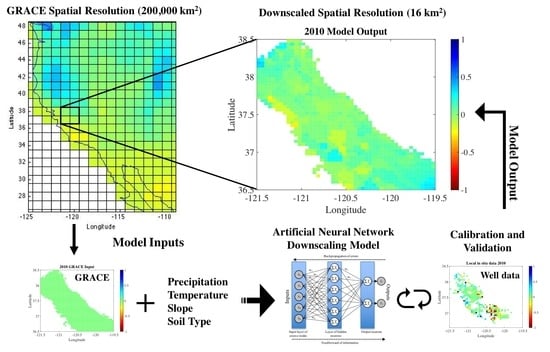Downscaling GRACE Remote Sensing Datasets to High-Resolution Groundwater Storage Change Maps of California’s Central Valley
Abstract
:1. Introduction
1.1. Downscaling GRACE Data
1.2. Goals and Objectives
2. Study Region: California’s Central Valley
3. The Neural Network Approach and Input Data
4. Results
4.1. Approach 1: In Situ Point Data for Calibration
4.2. Approach 2: Kriged Groundwater Surface for Calibration
4.3. Approach 3: Kriged Groundwater Surface for Calibration (2002–2006) with Validation over Entire Surface (2007–2010)
4.4. Finalized Neural Network Model Results
5. Discussion
6. Conclusions
Acknowledgments
Author Contributions
Conflicts of Interest
References
- Taylor, C.; Alley, W. Ground-Water-Level Monitoring and the Importance of Long-Term Water-Level Data; USGS Circular 1217; USGS: Reston, VA, USA, 2001. Available online: http://pubs.usgs.gov/circ/circ1217/pdf/circular1217.pdf (accessed on 20 August 2017).
- Faunt, C. Groundwater Availability of the Central Valley Aquifer, California; USGS Professional Paper 1766; USGS: Reston, VA, USA, 2009. Available online: http://pubs.usgs.gov/pp/1766/ (accessed on 20 August 2017).
- Faunt, C.; Sneed, M. Water Availability and Subsidence in California’s Central Valley. San Franc. Estuary Watershed Sci. 2015, 13. Available online: http://escholarship.org/uc/item/6qn2711x (accessed on 20 August 2017). [CrossRef]
- Mogheir, Y.; De Lima, J.L.M.P.; Singh, V.P. Assessment of Informativeness of Groundwater Monitoring in Developing Regions (Gaza Strip Case Study). Water Resour. Manag. 2005, 19, 737. [Google Scholar] [CrossRef]
- Shah, T.; Molden, D.; Sakthivadivel, R.; Seckler, D. The Global Groundwater Situation: Overview of Opportunities and Challenges; International Water Management Institute: Colombo, Sri Lanka, 2000; Available online: http://publications.iwmi.org/pdf/H025885.pdf (accessed on 20 August 2017).
- Harbaugh, A.; Banta, E.; Hill, M.; McDonald, M. MODFLOW-2000, the U.S. Geological Survey Modular Ground-Water Model—User Guide to Moduralization Concepts and the Ground-Water Flow Process; USGS: Reston, VA, USA, 2000. Available online: https://pubs.usgs.gov/of/2000/0092/report.pdf (accessed on 20 August 2017).
- Dagan, G. Stochastic modeling of groundwater flow by unconditional and conditional probabilities: 1. Conditional simulation and the direct problem. Water Resour. Res. 1982, 18, 813–833. [Google Scholar] [CrossRef]
- Hendricks Franssen, H.J.; Kinzelbach, W. Real-time groundwater flow modeling with the Ensemble Kalman Filter: Joint estimation of states and parameters and the filter inbreeding problem. Water Resour. Res. 2008, 44. [Google Scholar] [CrossRef]
- Reed, P.; Minsker, R.; Valocchi, A. Cost-effective long-term groundwater monitoring design using a genetic algorithm and global mass interpolation. Water Resour. Res. 2000, 36, 3731–3741. [Google Scholar] [CrossRef]
- Hughes, J.; Lettenmaier, D. Data requirements for kriging: Estimation and network design. Water Resour. Res. 1981, 17, 1641–1650. [Google Scholar] [CrossRef]
- Kitanidis, P.; Vomvoris, E. A geostatistical approach to the inverse problem in groundwater modeling (steady state) and one-dimensional simulations. Water Resour. Res. 1983, 19, 677–690. [Google Scholar] [CrossRef]
- Sun, Y.; Kang, S.; Li, F.; Zhang, L. Comparison of interpolation methods for depth to groundwater and its temporal and spatial variations in the Minqin oasis of northwest China. Environ. Model. Softw. 2009, 24, 1163–1170. [Google Scholar] [CrossRef]
- Rodell, M.; Famiglietti, J.S. The potential for satellite-based monitoring of groundwater storage changes using GRACE: The High Plains aquifer, Central US. J. Hydrol. 2003, 263, 245–256. [Google Scholar] [CrossRef]
- Yeh, P.; Swenson, S.; Famiglietti, J.S.; Rodell, M. Remote sensing of groundwater storage changes in Illinois using the Gravity Recovery and Climate Experiment (GRACE). Water Resour. Res. 2009, 42. [Google Scholar] [CrossRef]
- Rodell, M.; Chen, J.; Kato, H.; Famiglietti, J.S.; Nigro, J.; Wilson, C.R. Estimating groundwater storage changes in the Mississippi River basin (USA) using GRACE. Hydrogeol. J. 2007, 15, 159–166. [Google Scholar] [CrossRef]
- Strassberg, G.; Scanlon, B.; Rodell, M. Comparison of seasonal terrestrial water storage variations from GRACE with groundwater-level measurements from the High Plains Aquifer (USA). Geophys. Res. Lett. 2007, 34. [Google Scholar] [CrossRef]
- Rodell, M.; Velicogna, I.; Famiglietti, J.S. Satellite-based estimates of groundwater depletion in India. Nature 2009, 460, 999–1002. [Google Scholar] [CrossRef] [PubMed]
- Famiglietti, J.S.; Lo, M.; Ho, S.L.; Bethune, J.; Anderson, K.; Syed, T.; Swenson, S.; de Linage, C.; Rodell, M. Satellites measure recent rates of groundwater depletion in California’s Central Valley. Geophys. Res. Lett. 2011, 38, L03403. [Google Scholar] [CrossRef]
- Munier, S.; Becker, M.; Maisongrande, P.; Cazenave, A. Using GRACE to detect Groundwater Storage variations: The cases of Canning Basin and Guarani Aquifer System. Int. Water Technol. J. 2012, 2, 2–13. [Google Scholar]
- Voss, K.; Famiglietti, J.S.; Lo, M.; de Linage, C.; Rodell, M.; Swenson, S.C. Groundwater depletion in the Middle East from GRACE with implications for transboundary water management in the Tigris-Euphrates-Western Iran region. Water Resour. Res. 2013, 49, 904–914. [Google Scholar] [CrossRef] [PubMed]
- Feng, W.; Zhong, M.; Lemoine, J.M.; Biancale, R.; Hsu, H.T.; Xia, J. Evaluation of groundwater depletion in North China using the Gravity Recovery and Climate Experiment (GRACE) data and ground-based measurements. Water Resour. Res. 2013, 49, 2110–2118. [Google Scholar] [CrossRef]
- Famiglietti, J.S. The global groundwater crisis. Nat. Clim. Chang. 2014, 4, 945–948. [Google Scholar] [CrossRef]
- Richey, A.S.; Thomas, B.F.; Lo, M.H.; Reager, J.T.; Famiglietti, J.S.; Voss, K.; Swenson, S.; Rodell, M. Quantifying renewable groundwater stress with GRACE. Water Resour. Res. 2015, 51, 5217–5238. [Google Scholar] [CrossRef] [PubMed]
- Richey, A.S.; Thomas, B.F.; Lo, M.H.; Famiglietti, J.S.; Swenson, S.; Rodell, M. Uncertainty in global groundwater storage estimates in a Total Groundwater Stress framework. Water Resour. Res. 2015, 51, 5198–5216. [Google Scholar] [CrossRef] [PubMed]
- Famiglietti, J.S.; Rodell, M. Water in the balance. Science 2013, 340, 1300–1301. [Google Scholar] [CrossRef] [PubMed]
- Alley, W.M.; Konikow, L.F. Bringing GRACE Down to Earth. Groundwater 2015, 53, 826–829. [Google Scholar] [CrossRef] [PubMed]
- Fekete, B.M.; Robarts, R.D.; Kumagai, M.; Nachtnebel, H.P.; Odada, E.; Zhulidov, A.V. Time for in situ renaissance. Science 2015, 349, 685–686. [Google Scholar] [CrossRef] [PubMed]
- Wilby, R.L.; Wigley, T.M.L. Downscaling general circulation model output: A review of methods and limitations. Prog. Phys. Geogr. 1997, 21, 530–548. [Google Scholar] [CrossRef]
- Zaitchik, B.; Rodell, M.; Reichle, R. Assimilation of GRACE Terrestrial Water Storage Data into a Land Surface Model: Results for the Mississippi River Basin. J. Hydrometeorol. 2008, 9, 535–548. [Google Scholar] [CrossRef]
- Schumacher, M.; Forootan, E.; van Dijk, A.I.J.M.; Müller Schmied, H.; Crosbie, R.S.; Kushche, J.; Döll, P. Improving drought simulations within the Murray-Darling Basin by combined calibration/assimilation of GRACE data into the WaterGAP Global Hydrology Model. Remote Sens. Environ. 2017, 204, 212–228. [Google Scholar] [CrossRef]
- Schoof, J. Statistical Downscaling in Climatology. Geogr. Compass 2013, 7, 249–265. [Google Scholar] [CrossRef]
- Wilby, R.L.; Wigley, T.M.L.; Conway, D.; Jones, P.D.; Hewitson, B.C.; Main, J.; Wilks, D.S. Statistical downscaling of general circulation model output: A comparison of methods. Water Resour. Res. 1998, 34, 2995–3008. [Google Scholar] [CrossRef]
- Forootan, E.; Rietbroek, R.; Kusche, J.; Sharifi, M.A.; Awange, J.L.; Schmidt, M.; Omondi, P.; Famiglietti, J. Separation of large scale water storage patterns over Iran using GRACE, altimetry and hydrological data. Remote Sens. Environ. 2014, 140, 580–595. [Google Scholar] [CrossRef]
- Wilby, R.L.; Charles, S.P.; Zorita, E.; Timbal, B.; Whetton, P.; Mearns, L.O. Guidelines for Use of Climate Scenarios Developed from Statistical Downscaling Methods. Task Group of Data and Scenario Support for Impacts and Climate Analysis (TGICA). Intergovernmental Panel on Climate Change. 2004. Available online: http://www.ipcc-data.org/guidelines/dgm_no1_v1_10-2003.pdf (accessed on 20 August 2017).
- Huang, H.Y.; Capps, S.; Huang, S.C.; Hall, A. Downscaling near-surface wind over complex terrain using a physically-based statistical modeling approach. Clim. Dyn. 2015, 44, 529–542. [Google Scholar] [CrossRef]
- Chiew, F.; Kirono, D.; Kent, D.; Frost, A.; Charles, S.P.; Timbal, B.; Nguyen, K.; Fu, G. Comparison of runoff modelled using rainfall from different downscaling methods for historical and future climates. J. Hydrol. 2010, 387, 10–23. [Google Scholar] [CrossRef]
- Fasbender, D.; Ouarda, T. Spatial Bayesian Model for Statistical Downscaling of AOGCM to Minimum and Maximum Daily Temperatures. J. Clim. 2010, 23, 5222–5242. [Google Scholar] [CrossRef]
- Frost, A.; Charles, S.; Timbal, B.; Chiew, F.; Mehrotra, R.; Nguyen, K.; Chandler, R.; McGregor, J.; Fu, G.; Kirono, D.; et al. A comparison of multi-site rainfall downscaling techniques under Australian conditions. J. Hydrol. 2011, 408, 1–18. [Google Scholar] [CrossRef]
- Schoof, J.; Pryor, S.C. Downscaling temperature and precipitation: A comparison of regression-based methods and artificial neural networks. Int. J. Climatol. 2001, 21, 773–790. [Google Scholar] [CrossRef]
- Dibike, Y.; Coulibaly, P. Temporal neural networks for downscaling climate variability and extremes. Neural Netw. 2006, 19, 135–144. [Google Scholar] [CrossRef] [PubMed]
- Fowler, H.J.; Blenkinsop, S.; Tebaldi, C. Linking climate change modelling to impacts studies: Recent advances in downscaling techniques for hydrological modeling. Int. J. Climatol. 2007, 27, 1547–1578. [Google Scholar] [CrossRef]
- French, M.; Krajewski, W.; Cuykendall, R. Rainfall forecasting in space and time using a neural network. J. Hydrol. 1992, 137, 1–31. [Google Scholar] [CrossRef]
- Zhu, A. Mapping soil landscape as spatial continua: The Neural Network Approach. Water Resour. Res. 2000, 36, 663–677. [Google Scholar] [CrossRef]
- Jin, L.; Lin, J.; Lin, K. Precipitation Prediction Modeling Using Neural Network and Empirical Orthogonal Function Base on Numerical Weather Forecast Production. In Proceedings of the 6th World Congress on Intelligent Control and Automation, Dalian, China, 21–23 June 2006. [Google Scholar]
- Chu, H.; Chang, L. Optimal control algorithm and neural network for dynamic groundwater management. Hydrol. Process. 2009, 23, 2765–2773. [Google Scholar] [CrossRef]
- Daliakopoulos, I.; Coulibaly, P.; Tsanis, I. Groundwater level forecasting using artificial neural networks. J. Hydrol. 2005, 309, 229–240. [Google Scholar] [CrossRef]
- Krishna, B.; Satyaji Rao, Y.R.; Vijaya, T. Modelling groundwater levels in an urban coastal aquifer using artificial neural networks. Hydrol. Process. 2008, 22, 1180–1188. [Google Scholar] [CrossRef]
- Yang, Z.; Lu, W.; Long, Y.; Li, P. Application and comparison of two prediction models for groundwater levels: A case study in Western Jilin Province, China. J. Arid Environ. 2009, 73, 487–492. [Google Scholar] [CrossRef]
- Yoon, H.; Jun, S.C.; Hyun, Y.; Bae, G.O.; Lee, K.K. A comparative study of artificial neural networks and support vector machines for predicting groundwater levels in a coastal aquifer. J. Hydrol. 2011, 396, 128–138. [Google Scholar] [CrossRef]
- Taormina, R.; Chau, K.; Sethi, R. Artificial neural network simulation of hourly groundwater levels in a coastal aquifer system of the Venice lagoon. Eng. Appl. Artif. Intell. 2012, 25, 1670–1676. [Google Scholar] [CrossRef]
- Ebrahimi, H.; Rajaee, T. Simulation of groundwater level variations using wavelet combined with neural network, linear regression and support vector machine. Glob. Planet. Chang. 2017, 148, 181–191. [Google Scholar] [CrossRef]
- Sahoo, S.; Russo, T.A.; Elliott, J.; Foster, I. Machine learning algorithms for modeling groundwater level changes in agricultural regions of the U.S. Water Resour. Res. 2017, 53, 3878–3895. [Google Scholar] [CrossRef]
- Sun, A. Predicting groundwater level changes using GRACE data. Water Resour. Res. 2013, 49, 5900–5912. [Google Scholar] [CrossRef]
- Hsu, K.; Goa, X.; Sorooshian, S.; Gupta, H. Precipitation Estimation from Remotely Sensed Information Using Artificial Neural Networks. J. Appl. Meteorol. 1997, 36, 1176–1190. [Google Scholar] [CrossRef]
- Hsu, K.; Gupta, H.V.; Sorooshian, S. Artificial Neural Network Modeling of the Rainfall-Runoff Process. Water Resour. Res. 1995, 31, 2517–2530. [Google Scholar] [CrossRef]
- Turban, E.; Sharda, R.; Aronson, J.E.; King, D.N. Business Intelligence: A Managerial Approach; Pearson Prentice Hall: Upper Saddle River, NJ, USA, 2008. [Google Scholar]
- Wiese, D.N. GRACE Monthly Global Water Mass Grids, NETCDF RELEASE 5.0. Ver. 5.0. PO.DAAC, CA, USA. 2015. Available online: http://grace.jpl.nasa.gov/data/get-data/jpl_global_mascons/ (accessed on 20 August 2017).
- Jet Propulsion Laboratory, GRACE Follow-On, California Institute of Technology. NASA. 2016. Available online: http://gracefo.jpl.nasa.gov/ (accessed on 20 August 2017).
- Howitt, R.; MacEwan, D.; Medellín-Azuara, J.; Lund, J.; Sumner, D. Economic Analysis of the 2015 Drought for California Agriculture. UC Davis Center for Watershed Science. 2015. Available online: https://watershed.ucdavis.edu/files/biblio/Final_Drought%20Report_08182015_Full_Report_WithAppendices.pdf (accessed on 20 August 2017).
- Farr, T.; Jones, C.; Lui, Z. Progress Report: Subsidence in the Central Valley, California, Sacramento (CA): California Department of Water Resources. 2015. Available online: http://water.ca.gov/groundwater/docs/NASA_REPORT.pdf (accessed on 20 August 2017).
- California Department of Water Resources, California’s Groundwater: Bulletin 118, California Department of Water Resources. 2016. Available online: http://www.water.ca.gov/groundwater/bulletin118/gwbasins.cfm (accessed on 20 August 2017).
- RMC, An Evaluation of California Groundwater Management Planning, California Water Foundation. Sacramento, CA. 2015. Available online: http://www.californiawaterfoundation.org/uploads/1405009350-GMPReport2014(00256304xA1C15).pdf (accessed on 20 August 2017).
- Lo, M.; Famiglietti, J.S. Irrigation in California’s Central Valley strengthens the southwestern U.S. water cycle. Geophys. Res. Lett. 2013, 40, 301–306. [Google Scholar] [CrossRef]
- California Department of Water Resources, Legislation, Sustainable Groundwater Management Act (SGMA), California Department of Water Resources. 2015. Available online: http://www.water.ca.gov/cagroundwater/legislation.cfm (accessed on 20 August 2017).
- Mathworks, Neural Network Toolbox, MATLAB. 2016. Available online: http://www.mathworks.com/products/neural-network/ (accessed on 20 August 2017).
- MacKay, D. Bayesian Interpolation. Neural Comput. 1992, 4, 415–447. [Google Scholar] [CrossRef]
- Lallahem, S.; Mania, J.; Hani, A.; Najjar, Y. On the use of neural networks to evaluate groundwater levels in fractured media. J. Hydrol. 2005, 307, 92–111. [Google Scholar] [CrossRef]
- Reager, J.T.; Famiglietti, J.S. Characteristic mega-basin water storage behavior using GRACE. Water Resour. Res. 2013, 49, 3314–3329. [Google Scholar] [CrossRef] [PubMed]
- Güntner, A. Improvement of Global Hydrologic Models Using GRACE Data. Surv. Geophys. 2008, 29, 375–397. [Google Scholar] [CrossRef]
- Cannon, A.J.; Whitfield, P.H. Downscaling recent streamflow conditions in British Columbia, Canada using ensemble neural network models. J. Hydrol. 2002, 259, 136–151. [Google Scholar] [CrossRef]
- Basheer, I.A.; Hajmeer, M. Artificial neural networks: Fundamentals, computing, design, and application. J. Microbiol. Methods 2000, 43, 3–31. [Google Scholar] [CrossRef]
- PRISM Climate Group, PRISM Climate Data, Northwest Alliance for Computational Science and Engineering, Oregon State University. 2014. Available online: http://www.prism.oregonstate.edu (accessed on 20 August 2017).
- USGS. 1/3-Arc Second National Elevation Dataset. U.S. Geological Survey. 2009. Available online: http://nationalmap.gov (accessed on 20 August 2017).
- NRCS. Gridded Soil Survey Geographic (gSSURGO) Database, USDA Natural Resources Conservation Service. 2014. Available online: https://gdg.sc.egov.usda.gov/ (accessed on 20 August 2017).
- Landerer, F.; Swenson, S. Accuracy of Scaled GRACE Terrestrial Water Storage estimates. Water Resour. Res. 2012, 48. [Google Scholar] [CrossRef]
- California Water Data Library, Contour Data Report, California Department of Water Resources. 2015. Available online: http://www.water.ca.gov/waterdatalibrary/ (accessed on 20 August 2017).
- California Department of Water Resources, California’s Groundwater: Bulletin 188—Update 2003, California Department of Water Resources. 2003. Available online: http://www.water.ca.gov/groundwater/bulletin118/docs/Bulletin_118_Update_2003.pdf (accessed on 20 August 2017).
- Burow, K.R.; Shelton, J.L.; Hevesi, J.A.; Weissmann, G.S. Hydrogeologic Characterization of the Modesto Area, San Joaquin Valley, California. U.S. Geological Survey Scientific Investigations Report. 2004. Available online: https://pubs.usgs.gov/sir/2004/5232/sir_2004-5232.pdf (accessed on 20 August 2017).
- Provost and Pritchard Consulting Group, Madera Regional Groundwater Management Plan. 2014. Available online: sgma.water.ca.gov/basinmod/docs/download/824 (accessed on 20 August 2017).
- Bertoldi, G.; Johnston, R.; Evenson, K.D. Groundwater in the Central Valley, California—A Summary Report, U.S. Geological Survey Professional Paper 1401-A. 1991. Available online: https://pubs.er.usgs.gov/publication/pp1401A (accessed on 20 August 2017).
- Zimmerman, D.; Pavlik, C.; Ruggles, A.; Armstrong, M. An Experimental Comparison of Ordinary and Universal Kriging and Inverse Distance Weighting. Math. Geol. 1999, 31, 375–390. [Google Scholar] [CrossRef]
- Delhomme, J.P. Kriging in the hydrosciences. Adv. Water Resour. 1978, 1, 251–266. [Google Scholar] [CrossRef]
- Martin, P.J.; Frind, E.G. Modeling a Complex Multi-Aquifer System: The Waterloo Moraine. GroundWater 1998, 36, 679–690. [Google Scholar] [CrossRef]
- Arétouyap, Z.; NjandjockNouck, P.; Nouayou, R.; GhomsiKemgang, F.E.; PiépiToko, A.D.; Asfahani, J. Lessening the adverse effect of the semivariogram model selection on an interpolative survey using kriging technique. SpringerPlus 2016, 5, 549. [Google Scholar] [CrossRef] [PubMed]
- Nikroo, L.; Kompani-Zare, M.; Sepaskhah, A.; Rashid, S.; Shamsi, F. Groundwater depth and elevation interpolation by kriging methods in Mohr basin of Fars Province in Iran. Environ. Monit. Assess. 2010, 166, 387–407. [Google Scholar] [CrossRef] [PubMed]
- Nash, J.E.; Sutcliffe, J.V. River flow forecasting through conceptual models: Part 1. A discussion of principles. J. Hydrol. 1970, 10, 282–290. [Google Scholar] [CrossRef]
- Garson, G. Interpreting neural network connection weights. Artif. Intell. Expert 1991, 6, 47–51. [Google Scholar]
- Song, K.; Park, Y.S.; Zheng, F.; Kang, H. The application of Artificial Neural Network (ANN) model to the simulation of denitrification rates in mesocosm-scale wetlands. Ecol. Inform. 2013, 16, 10–16. [Google Scholar] [CrossRef]
- Brosse, S.; Guegan, J.F.; Tourenq, J.N.; Lek, S. The use of artificial neural networks to assess fish abundance and spatial occupancy in the littoral zone of a mesotrophic lake. Ecol. Model. 1999, 120, 2–3. [Google Scholar] [CrossRef]
- Gevrey, M.; Dimopoulos, I.; Lek, S. Review and comparison of methods to study the contribution of variables in artificial neural network models. Ecol. Model. 2003, 160, 249–264. [Google Scholar] [CrossRef]
- Olden, J.; Jackson, D. Illuminating the “black box”: A randomization approach for understanding variable contributions in artificial neural networks. Ecol. Model. 2002, 154, 135–150. [Google Scholar] [CrossRef]
- Moriasi, D.; Arnold, J.; Van Liew, M.; Bingner, R.; Harmel, R.; Veith, T. Model evaluation guidelines for systemic quantification of accuracy in watershed simulations. Trans. ASABE 2007, 50, 885–900. [Google Scholar] [CrossRef]
- Rowlands, D.; Luthcke, S.; Klosko, S.; Lemoine, F.; Chinn, D.; McCarthy, J.; Cox, C.; Anderson, O. Resolving mass flux at high spatial and temporal resolution using GRACE intersatellite measurements. Geophys. Res. Lett. 2005, 32. [Google Scholar] [CrossRef]
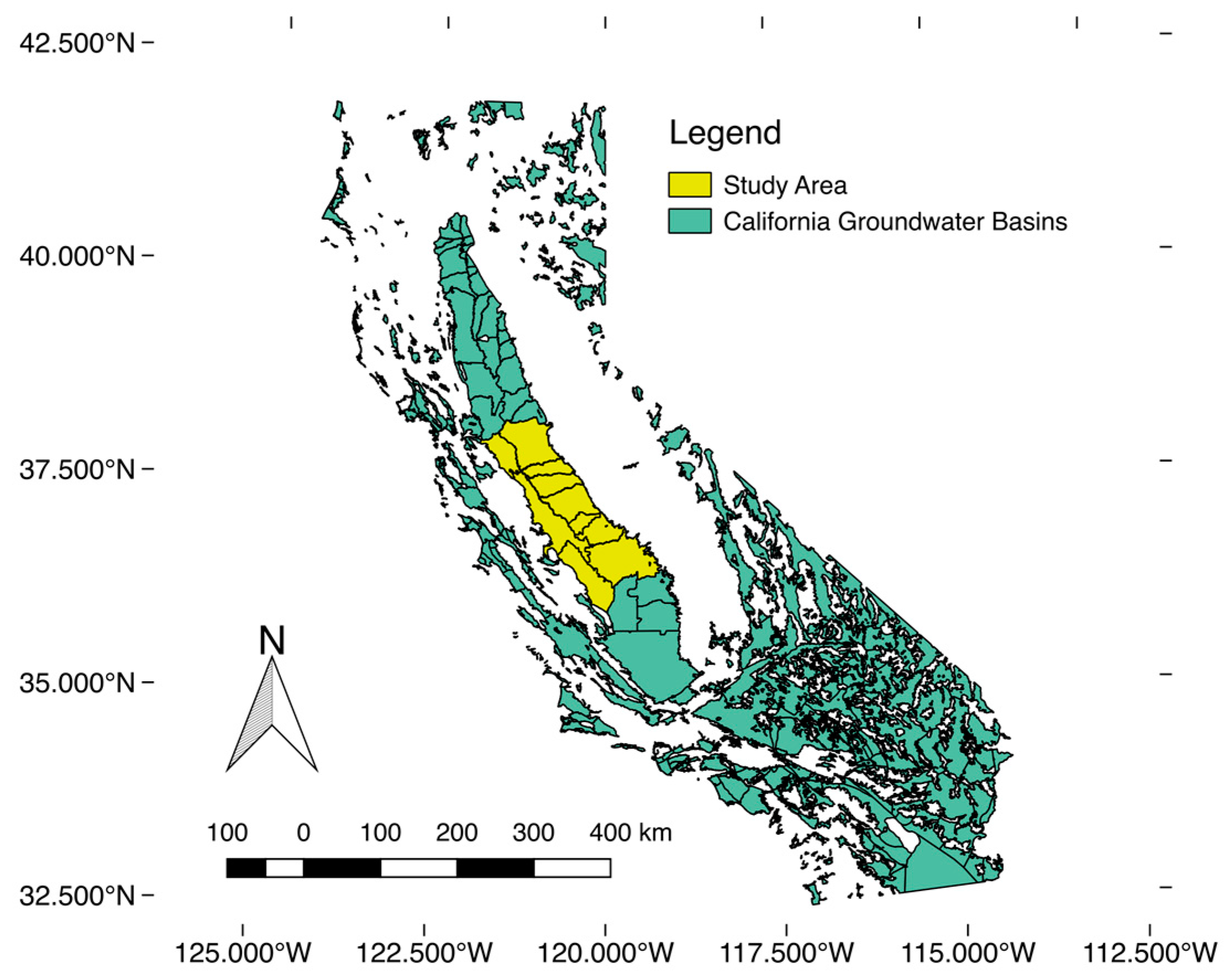
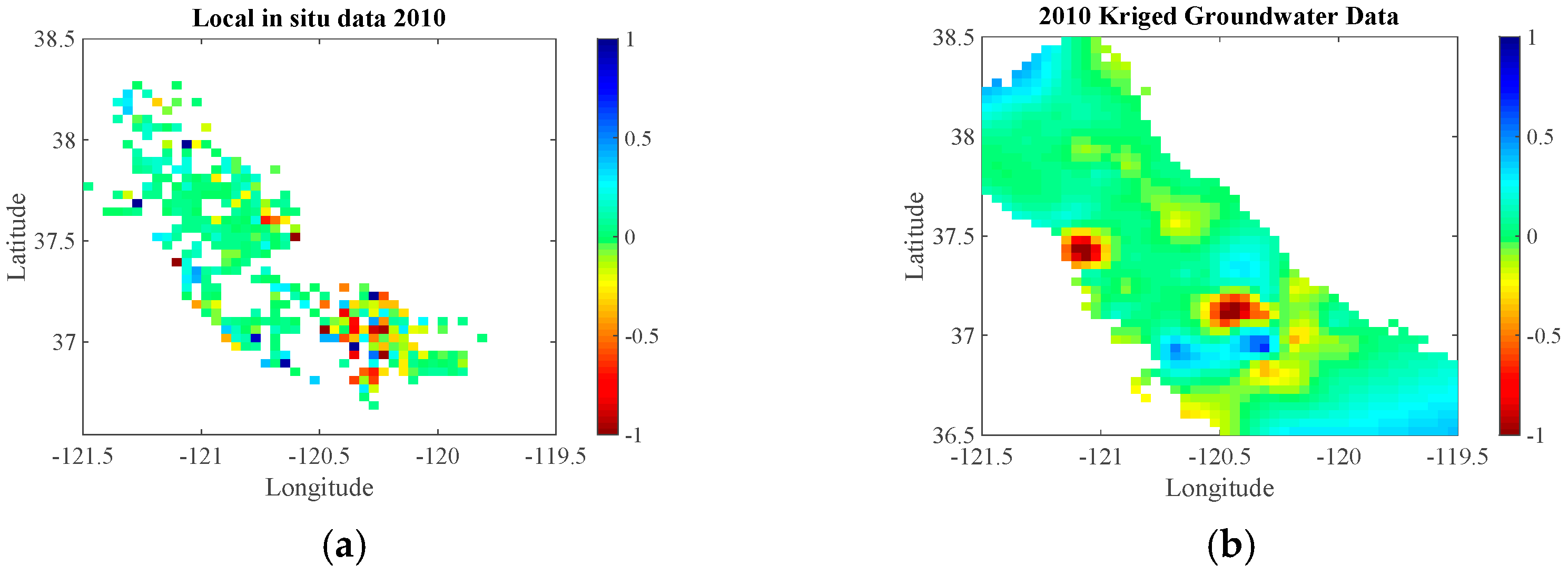
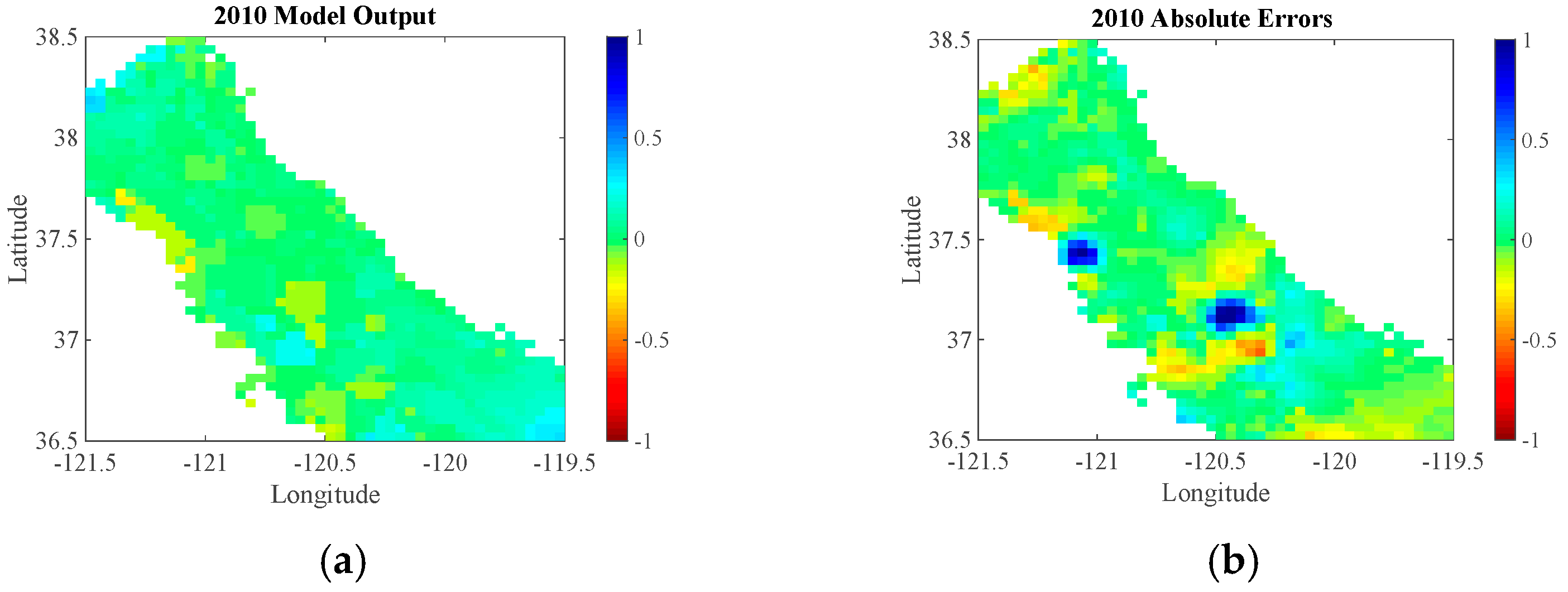
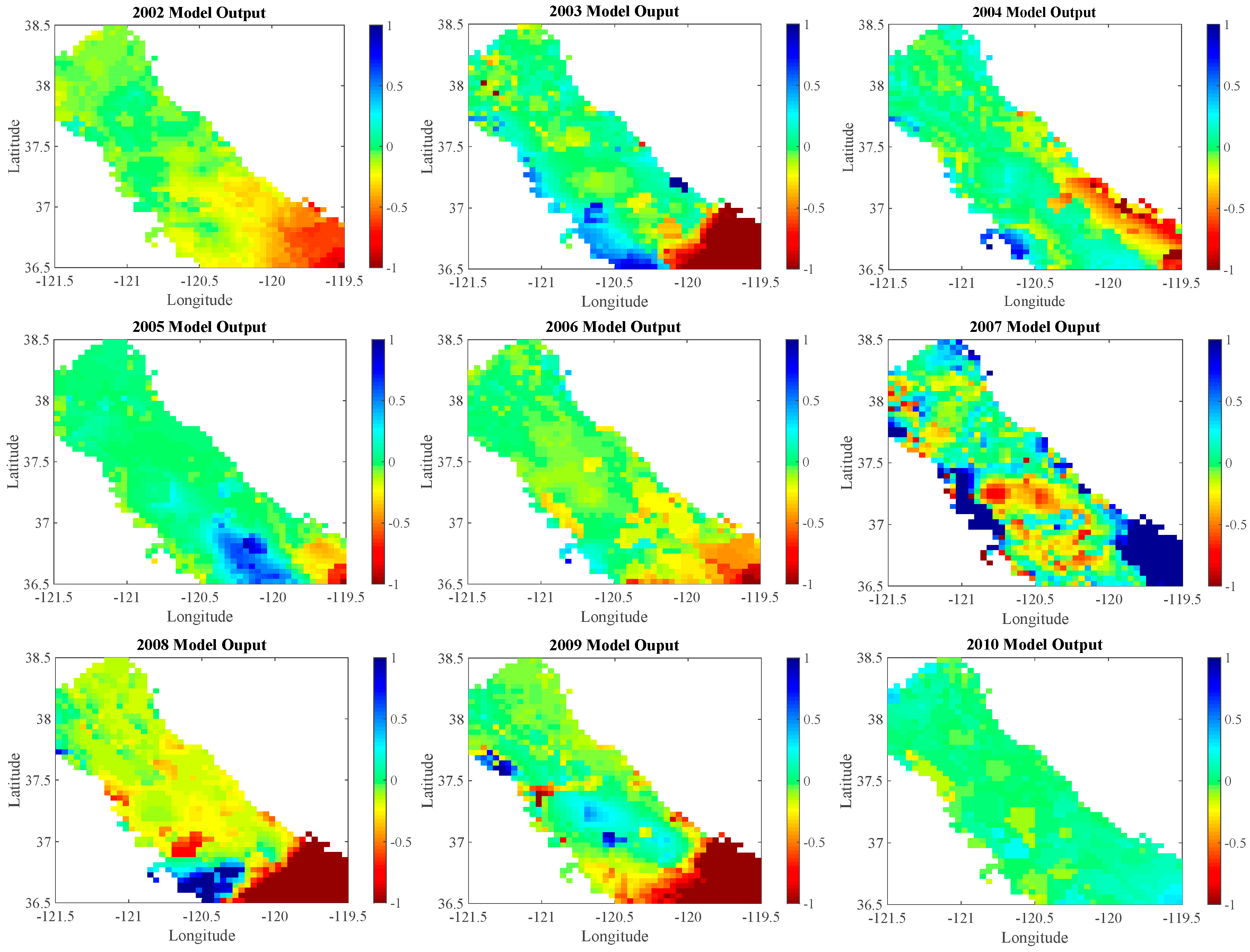
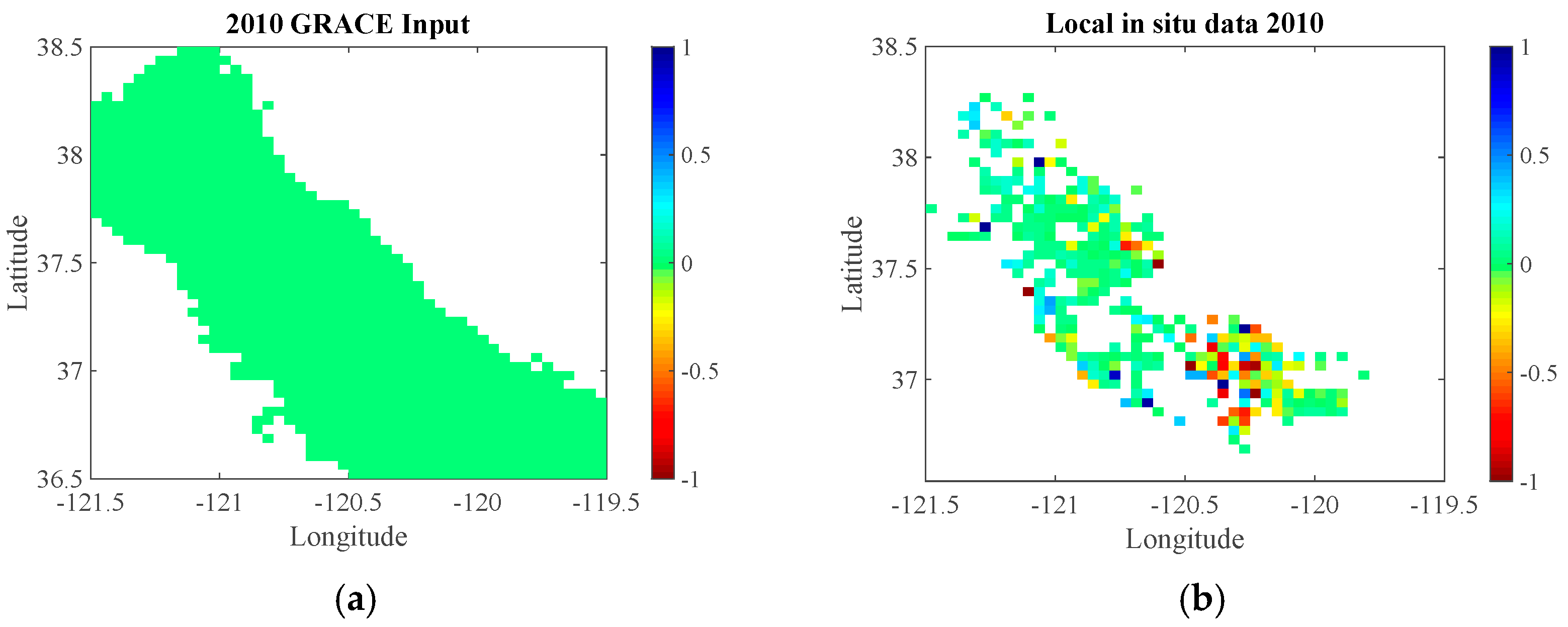
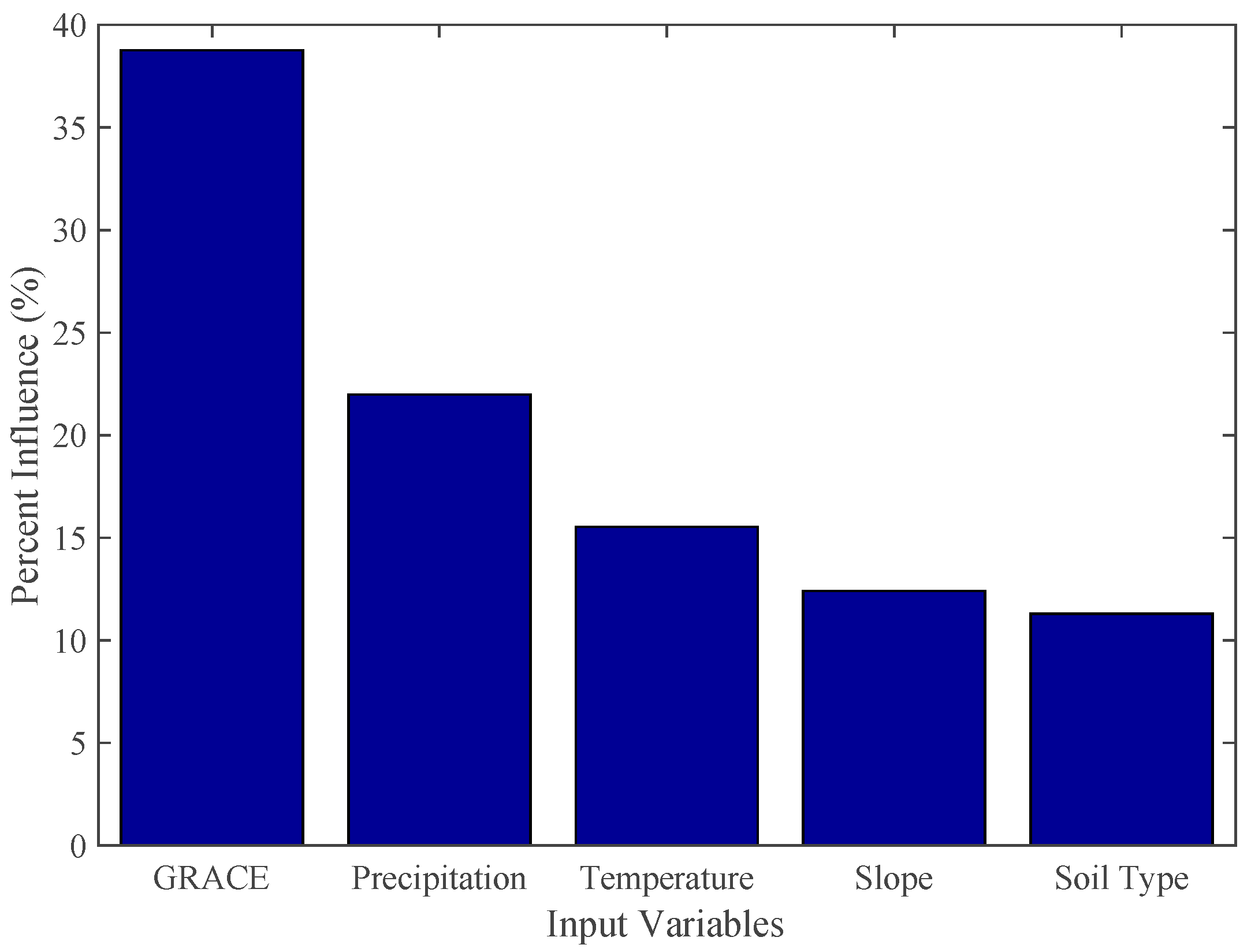
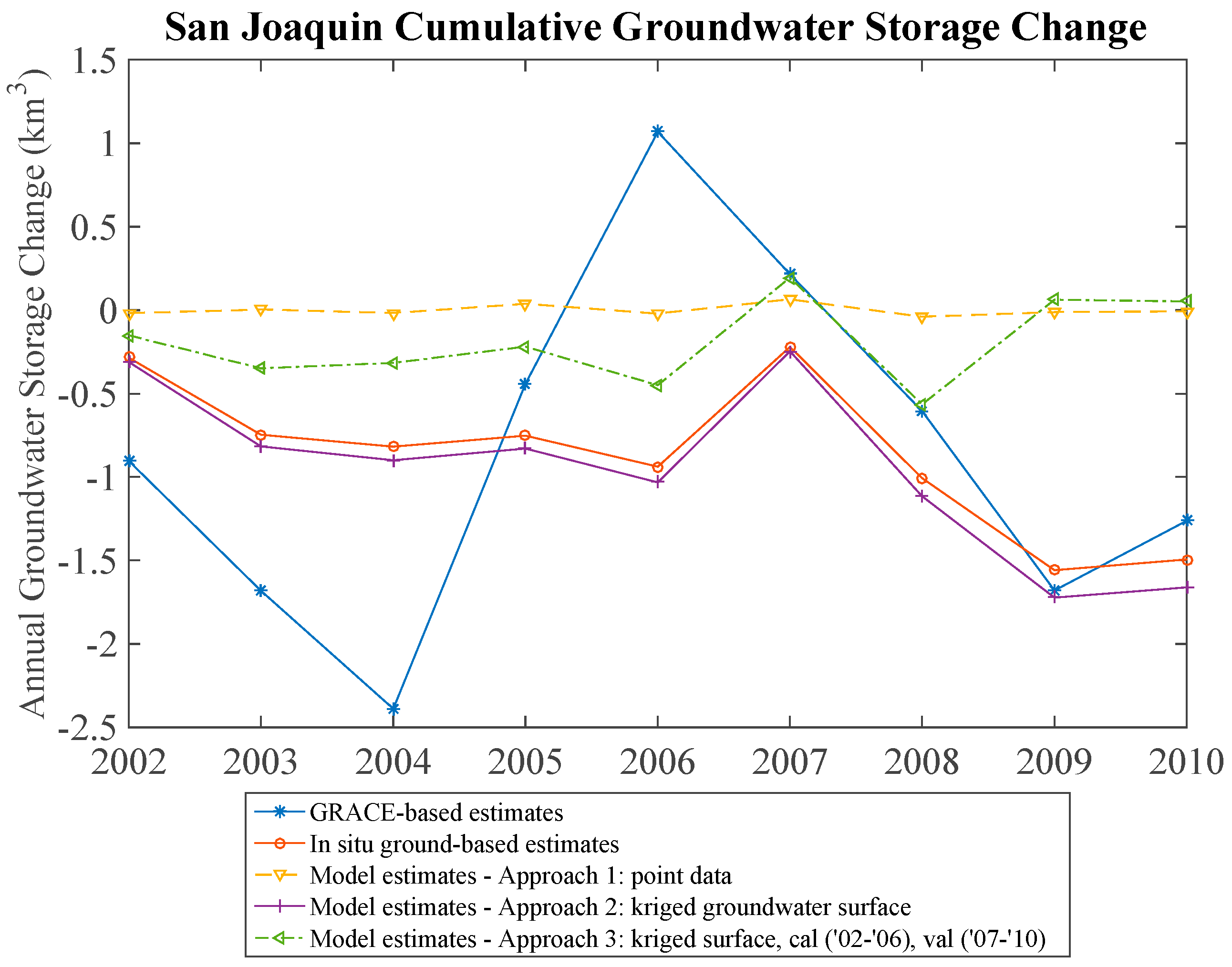
| Year | Calibration Results | Validation Results | ||||
|---|---|---|---|---|---|---|
| NSE | Corr. Coeff. | RMSE (m) | NSE | Corr. Coeff. | RMSE (m) | |
| 2002 | 0.5185 | 0.1665 | 0.0512 | 0.1435 | 0.1222 | 0.0586 |
| 2003 | 0.8731 | 0.2543 | 0.1210 | 0.4831 | 0.3098 | 0.1061 |
| 2004 | 0.3555 | 0.3578 | 0.1036 | 0.1569 | 0.3397 | 0.0845 |
| 2005 | 0.3603 | 0.2745 | 0.0814 | 0.0967 | 0.2397 | 0.0941 |
| 2006 | 0.2683 | 0.1566 | 0.0861 | 0.0683 | 0.1770 | 0.1200 |
| 2007 | 0.1580 | 0.4180 | 0.5608 | 0.5851 | 0.2489 | 0.1044 |
| 2008 | 0.8732 | 0.2189 | 0.1215 | 0.2977 | 0.2211 | 0.1263 |
| 2009 | 0.8152 | 0.2340 | 0.1159 | 0.0773 | 0.1426 | 0.1466 |
| 2010 | 0.0448 | 0.1749 | 0.0853 | 0.1676 | 0.0818 | 0.1099 |
| Year | Calibration Results | Validation Results | ||||
|---|---|---|---|---|---|---|
| NSE | Corr. Coeff. | RMSE (m) | NSE | Corr. Coeff. | RMSE (m) | |
| 2002 | 0.8364 | 0.9146 | 0.0266 | 0.3981 | 0.6359 | 0.0610 |
| 2003 | 0.9431 | 0.9717 | 0.0800 | 0.7511 | 0.8907 | 0.2390 |
| 2004 | 0.5624 | 0.7502 | 0.0754 | 0.0692 | 0.5227 | 0.3698 |
| 2005 | 0.6976 | 0.8393 | 0.0414 | 0.3185 | 0.5798 | 0.1326 |
| 2006 | 0.5799 | 0.7604 | 0.0511 | 0.0453 | 0.1602 | 0.0818 |
| 2007 | 0.6111 | 0.7826 | 0.3772 | 0.2096 | 0.3102 | 0.6236 |
| 2008 | 0.9577 | 0.9787 | 0.0690 | 0.3285 | 0.7219 | 0.2114 |
| 2009 | 0.8721 | 0.9365 | 0.1236 | 0.0391 | 0.7560 | 0.1924 |
| 2010 | 0.2445 | 0.4966 | 0.0541 | 0.2547 | 0.4843 | 0.0519 |
| Calibration (2002–2006), Validation (2007–2010) | |||
|---|---|---|---|
| Year | NSE | Corr. Coeff. | RMSE (m) |
| 2002 | 0.5509 | 0.7429 | 0.0240 |
| 2003 | 0.8752 | 0.9355 | 0.0673 |
| 2004 | 0.6887 | 0.8302 | 0.0582 |
| 2005 | 0.8360 | 0.9143 | 0.0471 |
| 2006 | 0.6839 | 0.8270 | 0.0479 |
| 2007 | −0.1029 | 0.1772 | 0.5246 |
| 2008 | −3.7980 | 0.1965 | 0.6708 |
| 2009 | −0.3598 | 0.2301 | 0.1605 |
| 2010 | −0.0029 | 0.3048 | 0.0642 |
© 2018 by the authors. Licensee MDPI, Basel, Switzerland. This article is an open access article distributed under the terms and conditions of the Creative Commons Attribution (CC BY) license (http://creativecommons.org/licenses/by/4.0/).
Share and Cite
Miro, M.E.; Famiglietti, J.S. Downscaling GRACE Remote Sensing Datasets to High-Resolution Groundwater Storage Change Maps of California’s Central Valley. Remote Sens. 2018, 10, 143. https://doi.org/10.3390/rs10010143
Miro ME, Famiglietti JS. Downscaling GRACE Remote Sensing Datasets to High-Resolution Groundwater Storage Change Maps of California’s Central Valley. Remote Sensing. 2018; 10(1):143. https://doi.org/10.3390/rs10010143
Chicago/Turabian StyleMiro, Michelle E., and James S. Famiglietti. 2018. "Downscaling GRACE Remote Sensing Datasets to High-Resolution Groundwater Storage Change Maps of California’s Central Valley" Remote Sensing 10, no. 1: 143. https://doi.org/10.3390/rs10010143
APA StyleMiro, M. E., & Famiglietti, J. S. (2018). Downscaling GRACE Remote Sensing Datasets to High-Resolution Groundwater Storage Change Maps of California’s Central Valley. Remote Sensing, 10(1), 143. https://doi.org/10.3390/rs10010143




